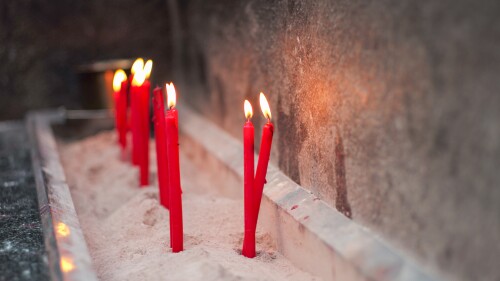Originally published under the title “Are Iranians Really Protesting against Islam?”
Thousands of protestors march through Mashhad chanting “Death to the Dictator!” on December 28. |
What began on December 28 as local protests against high food prices in the northern city of Mashhad, Iran, has spiraled into mass protests by hundreds of thousands of Iranians in some two dozen cities, including if not especially Tehran, the seat of government. So far over 20 protesters have been killed and many hundreds arrested in what has been widely described as “the most serious internal crisis the country has faced this decade.”
The protests have morphed from mundane topics concerning the economy to more existential topics concerning Islamic leadership. Reportedly hundreds of thousands of protesters have been heard shouting “We don’t want an Islamic Republic,” and calling blessings on Reza Shah, the staunch secularist and political reformer who did much to Westernize Iran, until his son and successor, Muhammad Reza Shah was deposed during the Islamic Revolution of 1979. According to Mideast media, women—such as Maryam Rajavi—are spearheading the current protests (and symbolically rejecting Islamic impositions by publicly removing their hijabs).
The protests have morphed from mundane economic issues to more existential topics concerning Islamic leadership.
Even the Iranian regime sees the current unrest as a revolt against Islam. In his initial remarks after demonstrations first erupted, Supreme Leader Ayatollah Khamenei said, “All those who are against the Islamic Republic ... have all joined forces in order to create problems for the Islamic Republic and the Islamic Revolution” (note the recurrent and telling adjective “Islamic”).
Even so, “mainstream media” see growing poverty and frustration at the lack of social freedoms as the only reasons behind the current unrest. Overlooked in their analysis is that, because Islam is not meant to be a “spiritual thing” one does privately, but is rather a complete system of governance, permeating the whole of private and social life, the ongoing protests in Iran, while ostensibly revolving around economic, social, and political issues, are ultimately protests against Islamic teachings concerning economic, social, and political issues, which the Islamic Republic of Iran has been imposing on the populace since coming to power in 1979.
This is evident even in the new rallying cry of the protestors—"Death to the Dictator"—in reference to Supreme Leader Ayatollah Ali Khamenei himself. By its very nature, Islamic law—both Sunni and Shia—calls for dictatorial rule. So long as the caliph, sultan, or emir governs society according to Sharia, Muslims must obey him—even if he is a despicable and cruel personage. After examining a number of Islamic rulings from authoritative exegetes, as well as a number of statements attributed to Muslim prophet Muhammad and in the Koran concerning the importance for Muslims to follow Islamic law—which is the only relevant question of when Muslims should and should not seek to overthrow their ruler—Ayman al-Zawahiri writes,
To summarize: It is forbidden to overthrow a tyrant, but it is a duty to overthrow an infidel. If the ruler is despotic, it is unlawful for a Muslim to rally other Muslims in order to condemn him, for if they do so then they become the aggressors and it becomes incumbent for the sultan to fight them (The Al Qaeda Reader, p. 122).
“All those who are against the Islamic Republic ... have all joined forces in order to create problems for the Islamic Republic and the Islamic Revolution,” according to Supreme Leader Ayatollah Khamenei. |
But even the economic aspects of the protests are largely by-products of Islamist aspirations. As Donald Trump tweeted last Friday, the Iranian “people are finally getting wise as to how their money and wealth is being stolen and squandered on terrorism.” Indeed, the economic suffering of the people has come at a time when the regime has grown rich—not least by Barack Obama giving them over $100 billion as part of a nuclear deal. The reason for the disparity is that the regime has been and continues to spend much of its wealth in trying to realize its stated Islamic ideals; that is, it prefers supporting Hezbollah (currently Forbes wealthiest terrorist organization) and Hamas (third wealthiest) against Islam’s arch “infidel” enemy, Israel, in the name of and for the greater glory of Allah, rather than feed its people.
Incidentally, because the right to protest is a given in the West, and thus occurs often—including over trivial and/or absurd matters, as when university students planned a “sh*t-in,” occupying restrooms as a way of demanding more “gender-neutral facilities"—the grave consequences of the current protests in Iran can easily be underestimated. Objectively speaking, they are indicative of just how fed up Iranians are—and the fatal risks they are willing to take—which, unsurprisingly, also trace back to Islam:
Protesters could also potentially face the death penalty when their cases come to trial, according to the head of Tehran’s Revolutionary Court, the AP reported. Iran’s semiofficial Tasnim news agency quoted Mousa Ghazanfarabadi as saying: “Obviously one of their charges can be Moharebeh,” or waging war against God [Allah], which is a death penalty offense in Iran.
Raymond Ibrahim is a Judith Friedman Rosen Fellow at the Middle East Forum.









